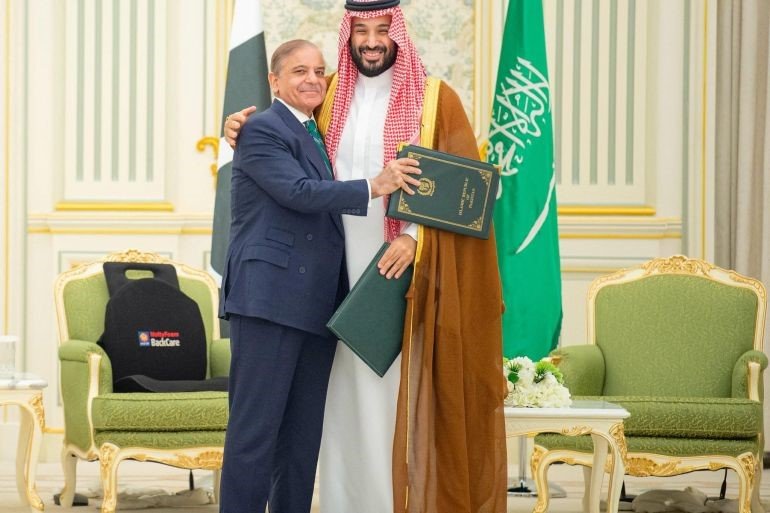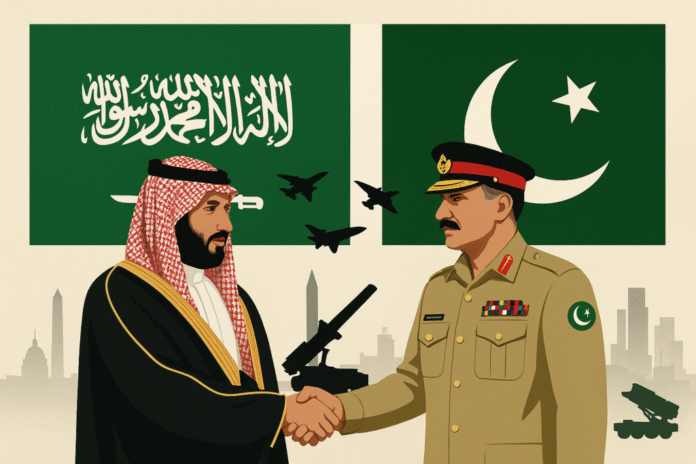Geo-politics has strange bed fellows. On September 17, 2025, Pakistan and Saudi Arabia formalised a major Strategic Mutual Defence Agreement. Under this treaty, any aggression against either country will be considered aggression against both. The purpose, according to joint statements, is to “develop aspects of defence cooperation and strengthen joint deterrence against any aggression”.
To understand this pact’s weight, it helps to recall the historical Saudi-Pakistan relationship. There have been close cultural, religious, and ideological bonds between the two countries since Pakistan’s founding and a large Pakistani expatriate community present in Saudi Arabia; oil, remittances, financial aid have long been regular features of cooperation or assured support to Saudi Arabia, when needed. Pakistan has trained Saudi forces, provided military advisors, participated in joint exercises. Previous defence cooperation has included advisory roles, and troop deployments during emergencies.
Pakistan’s nuclear capability adds an extra dimension. Saudi Arabia has been rumoured, in various policy discussions and media or analyst’s speculation, to have been exploring the idea of a “nuclear umbrella” via Pakistan, although official statements have remained ambiguous.
Prior to this treaty, none of this cooperation carried the formal binding condition that “an attack on one is an attack on both”.
Key Provisions & Immediate Meaning
Although the full text is not publicly available (as of writing), reports describe some of the treaty’s key features:
- A formal statement that aggression against one country shall be considered aggression against both.
- Clauses to strengthen defence cooperation and joint deterrence across various military and defensive means.
- Ambiguity remains over exactly how far the obligations go: what types of “aggression,” geographic scope, means (e.g. is nuclear response included?), what military/operational posture is expected.
Also, Saudi Arabia has publicly emphasised that this pact does not mean a shift in its diplomatic relations with India. The Kingdom has stated that its relationship with India remains “more robust than it has ever been”.
There have been close cultural, religious, and ideological bonds between the two countries since Pakistan’s founding and a large Pakistani expatriate community present in Saudi Arabia; oil, remittances, financial aid have long been regular features of cooperation or assured support to Saudi Arabia, when needed. Pakistan has trained Saudi forces, provided military advisors, participated in joint exercises. Previous defence cooperation has included advisory roles, and troop deployments during emergencies
Implications for Pakistan
Security Assurance and Deterrence: Pakistan gains a formal ally in the Gulf, who will be compelled (by treaty) to respond in case of any aggression. This may enhance Islamabad’s deterrence calculus, especially regarding threats from India, or from non-state actors.
Legitimacy & Political Capital: The treaty boosts Pakistan in diplomatic forums. It underscores that Pakistan isn’t isolated and retains a strategic value. It may also help in bilateral bargaining with other powers (China, USA, etc.) by showing Pakistan’s ability to leverage alliances.
Economic or Military Aid: Saudi Arabia has long been a donor (financial support, energy credit, etc.) to Pakistan. Defence cooperation may come with increased arms transfers, training, financial investments, maybe even infrastructure or base access. For a country with economic challenges, this is an important benefit.
Strategic Leverage vs. India: Formalising ties with Saudi Arabia enhances Pakistan’s strategic position vis-à-vis India. Pakistan can claim that any major regional confrontation may draw Saudi involvement, making Indian options more complex.
Risks and Responsibilities
Obligatory Defence Burden: With obligations come risks. Pakistan may be required to commit forces, provide logistic or operational support in case Saudi Arabia is attacked, possibly far from Lahore or Islamabad. This could stretch Pakistan’s military, already engaged on multiple fronts (terrorism, internal security, border management).
Ambiguity in Nuclear Role: As Pakistan possesses nuclear weapons, a question arises: does the defence pact include a nuclear umbrella? If so, then risks of escalation are dramatically higher. If not, then Saudi Arabia may feel exposed. But public statements have so far avoided confirmation of nuclear liability.
Diplomatic Repercussion: Pakistan must ensure that this treaty does not alienate other partners (like China, perhaps Iran too) or risk being seen as part of an alignment that could provoke adversaries. There is also a risk that this could drag Pakistan into conflicts it might otherwise would have avoided.
Economic Cost: Sustaining enhanced military readiness, joint operations, possibly stationing troops, logistic support — all require resources. Given Pakistan’s current economic fragility, this could place additional strain.
Implications for Saudi Arabia
Diversification of Security Providers: Historically Saudi Arabia has leaned heavily on the United States and Western partners for its security. But uncertainty (whether from changing US foreign policy, perceived unreliability, or regional threat perceptions) has pushed Riyadh to diversify. Tying formally with Pakistan gives it a regional buffer.
Enhanced Deterrence: If an adversary knows that Saudi is backed by Pakistan militarily, it may be deterred from aggression. The presence of a nuclear-armed ally (Pakistan) can also raise the stakes for attackers, though again nuclear extendibility is murky.
Regional Reach and Projection: With Pakistan’s military experience (especially in difficult terrain, counter-insurgency, etc.), Saudi Arabia may benefit from Pakistani expertise, joint training, perhaps even joint forces if needed.
Political and Religious Legitimacy: Saudi Arabia positions itself as a leader in the Muslim world. Solidifying ties with Pakistan reinforces its Islamic credentials, particularly in times of heightened regional conflict (e.g. situations involving Palestinians, etc.).
Strategic Hedging: By maintaining ties both with Pakistan and with India, Saudi Arabia hedges its options. It can draw strength from Pakistan, while maintaining trade, investment, diplomatic ties with India and others. This flexibility is important.
Pakistan’s nuclear capability adds an extra dimension to the Saudi-Pak Defence Pact. Saudi Arabia has been rumoured, in various policy discussions and media or analyst’s speculation, to have been exploring the idea of a “nuclear umbrella” via Pakistan, although official statements have remained ambiguous
Risks and Constraints
Commitment Risk: The defence pact may oblige Saudi Arabia to military or logistical commitments outside its preferred scope. Engaging in conflicts on Pakistan’s border or supporting Pakistan in a conflict with India could draw Saudi into unwanted escalation.
Ambiguity and Misunderstanding. What counts as “aggression”? Is it limited to state adversary, or does non-state actor and cross-border attacks too, qualify as aggression? Does it include cyber, missile, drone attacks? These definitions matter. If ambiguous, expectations may diverge, leading to miscalculation.
Risk to Relations with Other Powers: India, for example, is a major trading partner. Saudi Arabia has emphasised continuity of relations with India, but any perception that the defence pact shifts its stance could strain ties. Also, relations with Iran and others might be complicated.
Escalation Risk: In volatile regions (Middle East, Persian Gulf), there’s a risk that this kind of pact could escalate crises. For example, if Saudi territory is attacked (say by groups backed by Iran, or by Iranian proxies), and Pakistan is invoked, the conflict could widen.
Domestic Limitations: Saudi Arabia’s own military capabilities, although strong, also have limitations: deployment capacity far from home, sustainment, maintaining readiness across multiple theatres. If commitments multiply, there is a risk of overstretch.
Implications for India
India has multiple strategic interests in this development. Because of Pakistan-India rivalry, the presence of Pakistan in a formal defence pact with another major state could affect India’s security, diplomatic, and foreign policy calculus.
Perception of Encirclement or Strategic Pressure: India may perceive that Pakistan is acquiring stronger external backing which could lower Pakistan’s threshold for confrontation. The knowledge that Pakistan has formal treaty support can shift dynamics in border engagements or in crises (such as cross-border skirmishes).
Saudi Arabia has publicly emphasised that this pact does not mean a shift in its diplomatic relations with India. The Kingdom has stated that its relationship with India remains “more robust than it has ever been”
Impact on India-Saudi Relations: Saudi Arabia has important trade, energy, and investment links with India. India needs stable relations with Gulf States to secure its energy imports and to engage in its diaspora/expatriate policy. A shift in Saudi’s strategic posture could potentially complicate these relations, depending on how Saudi balances ties. India will watch carefully for any indication that Saudi’s pact with Pakistan undermines or reduces its openness to India.
Nuclear Deterrence Balance: If Pakistan’s nuclear deterrent is implicitly or explicitly extended via this pact (i.e., implicating Saudi Arabia under Pakistan’s deterrence umbrella), then India’s nuclear posture and calculations regarding first use, launch under warning, etc., could be influenced. Even if it’s not explicit, the possibility adds a layer of complexity.
Diplomatic Realignments and Foreign Policy Adjustments: India may be prompted to deepen its own alliances or to reassure partners. India has been growing ties with Gulf nations (Saudi, UAE, etc.) in trade, infrastructure, investment, energy, and strategic cooperation (port, naval exercises, etc.). India may increase its strategic diplomacy to ensure that Gulf States continue to see India as an important partner even they build security ties with Pakistan.
Border Security and Military Preparedness: While India’s immediate threat is from Pakistan (and China), this pact may incite India to reassess military readiness along its western front, including logistics, air defence, surveillance, to ensure that any increased Pakistani backing or emboldening does not catch India off-guard.

Potential Responses from India
Diplomatic Engagement: Reaffirming and expanding bilateral relations with Saudi Arabia, underlining shared interests, to maintain goodwill and strategic linkage.
Deepening Gulf Partnerships: Expanding cooperation with other Gulf monarchies, perhaps enhancing joint security dialogues, counterterrorism cooperation, and intelligence sharing.
The treaty boosts Pakistan in diplomatic forums. It underscores that Pakistan isn’t isolated and retains a strategic value. It may also help in bilateral bargaining with other powers (China, USA, etc.) by showing Pakistan’s ability to leverage alliances
Strategic Defence Enhancements: Possibly accelerating modernisation, force readiness and increasing attention to defending against external threats from West and Northwest.
Multilateral Forums: Emphasising international rules, perhaps raising in UN, Arab League, OIC, etc., that conflicts should be resolved peacefully. Ensuring that any treaty doesn’t violate norms.
Balancing with Diplomacy toward Pakistan: India may choose to adjust its posture with Pakistan in terms of ceasefire or infiltration issues, keeping more robust deterrence signalling.
It’s important to note what this pact does not do at present:
It is not a public, detailed defence treaty with full clarifications of military obligations. Many of the operational, logistical, nuclear aspects are not explicit.
It does not (so far) seem to cut Saudi ties with other powers (US, India, etc.). Saudi Arabia has explicitly said that this pact does not represent a shift away from India.
It does not guarantee that Pakistan will commit to any conflict automatically; domestic politics, economic constraints, and capability limitations will matter.
Given the above, here are some concluding reflections and what different actors might consider doing:
Strategic clarity needed: Both Pakistan and Saudi Arabia should clarify, publicly or in internal documents, definitions of what constitutes “aggression,” scope of obligation, and mechanisms of deterrence. This will reduce misunderstandings.
Both Pakistan and Saudi Arabia should clarify, publicly or in internal documents, definitions of what constitutes “aggression,” scope of obligation, and mechanisms of deterrence. This will reduce misunderstandings
Manage expectations in nuclear domain: If Pakistan is being implicitly asked to extend nuclear deterrence, that must be managed carefully—internationally (with respect to non-proliferation norms) and regionally (to avoid escalation).
India should engage diplomatically: India should ensure that its relations with Saudi Arabia and other Gulf states remain strong, emphasising mutual economic, energy, and security interdependence. India may also need to show it remains a partner, not an adversary, even as regional alliances shift.
Capacity building & deterrence readiness: For Pakistan, the key will be ensuring that its military and logistics capabilities match the treaty’s expectations without jeopardising internal security. For Saudi Arabia, ensuring that its defence budget, procurement, and human resource capacity align.
Avoiding escalation through diplomacy: In volatile conflicts (e.g. Israel-Hamas, Yemen, Iran proxy conflicts) both sides should use diplomacy, back-channel communications to ensure that the treaty obligations do not lead to automatic escalation.
-The author retired as Major General, Army Ordnance Corps, Central Command, after 37 years of service. A management doctorate and expert on defence modernisation, he is the author of four books, including the Amazon bestseller “Breaking the Chinese Myth,” and a frequent media commentator. He is affiliated with several leading defence and strategic studies institutions in New Delhi. The views expressed are of the writer and do not necessarily reflect the views of Raksha Anirveda






